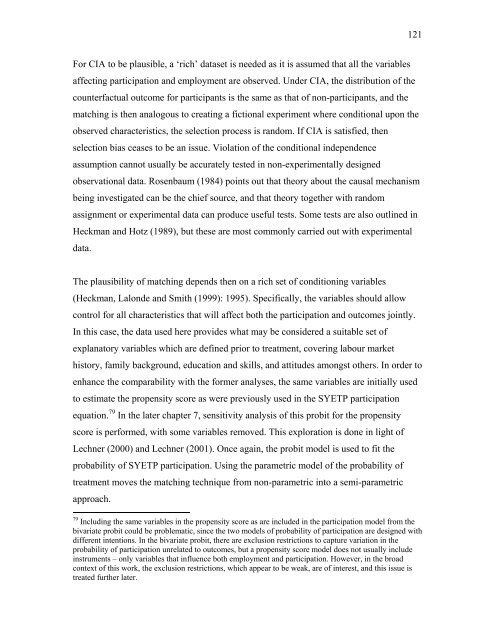Evaluation of the Australian Wage Subsidy Special Youth ...
Evaluation of the Australian Wage Subsidy Special Youth ...
Evaluation of the Australian Wage Subsidy Special Youth ...
You also want an ePaper? Increase the reach of your titles
YUMPU automatically turns print PDFs into web optimized ePapers that Google loves.
121<br />
For CIA to be plausible, a ‘rich’ dataset is needed as it is assumed that all <strong>the</strong> variables<br />
affecting participation and employment are observed. Under CIA, <strong>the</strong> distribution <strong>of</strong> <strong>the</strong><br />
counterfactual outcome for participants is <strong>the</strong> same as that <strong>of</strong> non-participants, and <strong>the</strong><br />
matching is <strong>the</strong>n analogous to creating a fictional experiment where conditional upon <strong>the</strong><br />
observed characteristics, <strong>the</strong> selection process is random. If CIA is satisfied, <strong>the</strong>n<br />
selection bias ceases to be an issue. Violation <strong>of</strong> <strong>the</strong> conditional independence<br />
assumption cannot usually be accurately tested in non-experimentally designed<br />
observational data. Rosenbaum (1984) points out that <strong>the</strong>ory about <strong>the</strong> causal mechanism<br />
being investigated can be <strong>the</strong> chief source, and that <strong>the</strong>ory toge<strong>the</strong>r with random<br />
assignment or experimental data can produce useful tests. Some tests are also outlined in<br />
Heckman and Hotz (1989), but <strong>the</strong>se are most commonly carried out with experimental<br />
data.<br />
The plausibility <strong>of</strong> matching depends <strong>the</strong>n on a rich set <strong>of</strong> conditioning variables<br />
(Heckman, Lalonde and Smith (1999): 1995). Specifically, <strong>the</strong> variables should allow<br />
control for all characteristics that will affect both <strong>the</strong> participation and outcomes jointly.<br />
In this case, <strong>the</strong> data used here provides what may be considered a suitable set <strong>of</strong><br />
explanatory variables which are defined prior to treatment, covering labour market<br />
history, family background, education and skills, and attitudes amongst o<strong>the</strong>rs. In order to<br />
enhance <strong>the</strong> comparability with <strong>the</strong> former analyses, <strong>the</strong> same variables are initially used<br />
to estimate <strong>the</strong> propensity score as were previously used in <strong>the</strong> SYETP participation<br />
equation. 79 In <strong>the</strong> later chapter 7, sensitivity analysis <strong>of</strong> this probit for <strong>the</strong> propensity<br />
score is performed, with some variables removed. This exploration is done in light <strong>of</strong><br />
Lechner (2000) and Lechner (2001). Once again, <strong>the</strong> probit model is used to fit <strong>the</strong><br />
probability <strong>of</strong> SYETP participation. Using <strong>the</strong> parametric model <strong>of</strong> <strong>the</strong> probability <strong>of</strong><br />
treatment moves <strong>the</strong> matching technique from non-parametric into a semi-parametric<br />
approach.<br />
79 Including <strong>the</strong> same variables in <strong>the</strong> propensity score as are included in <strong>the</strong> participation model from <strong>the</strong><br />
bivariate probit could be problematic, since <strong>the</strong> two models <strong>of</strong> probability <strong>of</strong> participation are designed with<br />
different intentions. In <strong>the</strong> bivariate probit, <strong>the</strong>re are exclusion restrictions to capture variation in <strong>the</strong><br />
probability <strong>of</strong> participation unrelated to outcomes, but a propensity score model does not usually include<br />
instruments – only variables that influence both employment and participation. However, in <strong>the</strong> broad<br />
context <strong>of</strong> this work, <strong>the</strong> exclusion restrictions, which appear to be weak, are <strong>of</strong> interest, and this issue is<br />
treated fur<strong>the</strong>r later.













